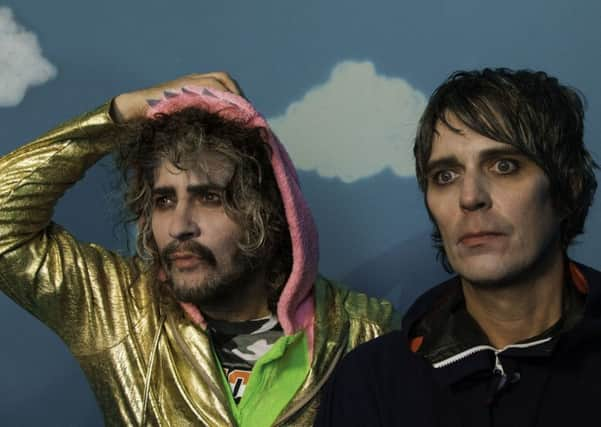Album reviews: Flaming Lips | Brian Eno | Mungo’s Hi Fi | Kyle Craft


The Flaming Lips: The King’s Mouth (Bella Union) ****
Brian Eno: Apollo: Atmospheres & Soundtracks (UMC) ***
Mungo’s Hi Fi X Eva Lazarus: More Fyah (Scotch Bonnet) ***
Kyle Craft: Showboat Honey (Sub Pop) ****
Oklahoma’s finest astral travellers, The Flaming Lips, continue their adventures down the psych rock rabbit hole with an eccentric-yet-accessible new album, a conceptual space oddity.
Inspired by frontman Wayne Coyne’s travelling immersive art installation of the same name, The King’s Mouth is a trippy fairytale about a giant baby monarch who absorbs the rage of the universe, thereby sacrificing himself for his people, who then slice open his head and parade it around the kingdom as a talisman – so perhaps not brothers Grimm standard, but with its own points to make about loss and legacy, rather brilliantly narrated by Mick Jones of The Clash. “It was a sad and bloody and wonderful happy day,” he intones.
Advertisement
Hide AdAdvertisement
Hide AdAround this deadpan fabulism, the band weave cosmic instrumental passages, such as the dreamy, pulsating Mother’s Universe, and Electric Fire, a space symphony of gauzy arpeggios, mournful strings, fuzzy bass notes and chorus pedals, with Coyne interjecting in childlike wonder. “How can a head hold so many things?” The pitch-shifted vocals and twinkling keyboards on How Many Times create a dread nursery rhyme vibe. All For the Life of the City is a twisted whimsical blend of psychedelic saga and requiem, while Mouth of a King is a relatively unadorned ode to remembrance. The whole thing just about hangs together on the Lips’ signature sonic cocktail of bittersweet melody and eccentric invention.
From space cadets to spacemen…Brian Eno’s Apollo: Atmospheres & Soundtracks was originally recorded with his brother Roger and producer Daniel Lanois for the 1983 moon landings documentary For All Mankind. Now it has been remastered and re-released to mark the 50th anniversary of the Apollo 11 mission with an additional 11 new tracks, which brought the trio together in the studio for the first time since 1983.
Eno creates his own sea of tranquillity with a pacific wash of sound. Star tracks from the original album include the more atmospheric and melodic likes of An Ending (Ascent) and Deep Blue Day, the ambient country track which soundtracked Trainspotting’s infamous toilet scene. The new compositions are similarly serene, if lacking some of the idiosyncracies which punctuated the earlier recordings, though Finegrained is a stately waltz of plangent piano and sonorous guitar and there is a hint of the baroque in the ringing drones of Like I Was A Spectator.
For their latest voyage, Glaswegian soundsystem Mungo’s Hi Fi ramp up the party in collaboration with MC/singerEva Lazarus, soon to be seen in the Fringe production Kid_X. Lazarus brings a summery touch to the appropriately titled Light As A Feather, delivers a warning shot across the bow with her breezy swing vocals on Gasoline and engages in a roots rumble with veteran reggae artist Max Romeo on Babylon Raid, as his old school ska meets her modern Jamaican dancehall.
Like Ezra Furman and The Lemon Twigs, Portland-based Kyle Craft is part of a generation of bold and bright and fearless US artists who draw gleefully on their country’s noble tradition of low-slung rock’n’roll, Seventies melodic balladry and New Wave pop. There’s British invasion influence too, as Kraft sounds like a gonzo Roger Daltrey and struts like Jagger on Showboat Honey– also the name of his freewheeling band. Together, they whoop it up on Blackhole/Joyride, and indulge shamelessly in the melodramatic sweep of Deathwish Blue, glam swagger of Buzzkill Caterwaul and sprawling Sunset Strip odysseyJohnny (Free & Easy). - Fiona Shepherd
CLASSICAL
Henri-Jacques de Croes: La Sonata Egarée (Linn) ****
Born in Belgium in 1705, Henri-Jacques de Croes occupies a chronological position between high Baroque and encroaching Classicism, and a geographical position on the periphery of the main central European action.
As such we hear, not least in these Six Trio Sonatas Op5, a style that is free to explore and ingest wide influences, from the easygoing flamboyance of Italy’s Corelli to the structured functionality of Germany (where he worked briefly), to the lyrical dash of the French Style Galant. These performances by BarrocoTout, a period ensemble formed four years ago in Brussels and which last year won the York Early Music International Young Artists Competition, are charming. The musicality is liquidly robust, faithful to de Croes’ effortless invention, its masterful contrapuntal invention and shapely lyricism, delightful to the ear at every turn. - Ken Walton
FOLK
Advertisement
Hide AdAdvertisement
Hide AdKaren Marshalsay: The Road to Kennacraig (Cramasie Records) ****
Harper Karen Marshalsay sets out her stall beguilingly with her title composition – notes plucked from wire-strung clarsach, hanging in the air before morphing into rippling, piobaireachd-style variations.
Playing gut-strung harp as well as wire-strung and medieval bray harps, she is influenced by Highland pipe music, particularly the piobaireachd in the venerable Battle of the Bridge of Perth. She switches to the gut-strung instrument for the lovely air St Fillan’s and the piping influence pervades other material, such as The Rhymer’s Reel or The Journeying Jig (the latter from a Celtic Connections New Voices commission).
Marshalsay dwells nicely on producer Robin Morton’s composition Ellen’s Dreams and on the gently chiming 18th-century Carrill’s Lament, while she multi-tracks on all three harps for the closing set, bray harp adding its eldritch buzz to MacKinnon’s Brook. - Jim Gilchrist